
Arhopala anthelus, the angelus bush blue, is a species of lycaenid or blue butterfly found in the Indomalayan realm.
Henley Grose-Smith (1833–1911) was an English entomologist who specialised in Lepidoptera.

Arhopala micale, the common oakblue or shining oakblue, is a butterfly of the family Lycaenidae. The species comprises about 16 subspecies, which are found in Melanesia and New Guinea as well as the north coast of Australia.

Papilio forbesi is a butterfly of the family Papilionidae. It is endemic to Sumatra.

Graphium polistratus, the dancing swordtail, is a butterfly in the family Papilionidae (swallowtails). It is found in Nigeria, the Democratic Republic of the Congo, the coast of Kenya, Tanzania, northern Malawi and Mozambique. Its habitat consists of warm and coastal forests.
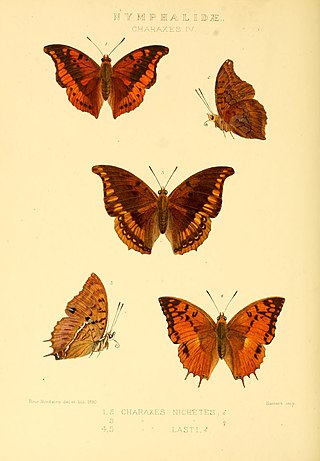
Charaxes lasti, the silver-striped charaxes, is a butterfly in the family Nymphalidae. It is found in Kenya and Tanzania.

Charaxes pythodoris, the powder-blue charaxes, is a butterfly in the family Nymphalidae. It is found in Sierra Leone, Ivory Coast, Ghana, Nigeria, Cameroon, Gabon, the Republic of the Congo, the Central African Republic, Angola, the Democratic Republic of the Congo, Ethiopia, Uganda, Kenya, Tanzania, Malawi and Zambia.

Arhopala aedias, the large metallic oakblue, is a species of butterfly belonging to the lycaenid family described by William Chapman Hewitson in 1862. It is found in Southeast Asia.
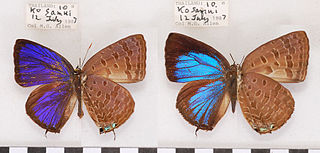
Arhopala aida or white-stained oakblue, is a species of butterfly belonging to the lycaenid family described by Lionel de Nicéville in 1889. It is found in Southeast Asia . The upper surface of the male is lilac the black marginal band on both wings above equally broad. The under surface is brown with a distinct violet gloss;forewing with a light hindmarginal area. The female is above bluer, lighter than the male, and has a much broader black margin. aida differs from Ahropalus myrtale in its darker and more violet-blue and its broad outer margins ; the undersides are, however, very much alike.
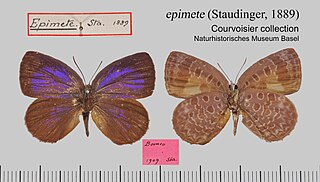
Arhopala epimete, the violetdisc oakblue, is a species of butterfly belonging to the lycaenid family described by Otto Staudinger in 1889. It is found in Southeast Asia.

Arhopala hellenore, Doherty's green oakblue, is a species of butterfly belonging to the lycaenid family described by William Doherty in 1889. It is found in Southeast Asia - Assam, Manipur, Burma, Mergui, Thailand, Indo China, Hainan Sumatra, Peninsular Malaya.

Arhopala adherbal is a butterfly in the family Lycaenidae. It was described by Henley Grose-Smith in 1902. It is found in the Australasian realm, where it has been recorded from Aru, Halmahera, Waigeu, and from western Irian to Papua New Guinea.

Arhopala antharita is a butterfly in the family Lycaenidae. It was described by Henley Grose-Smith in 1894. It is found in New Guinea.
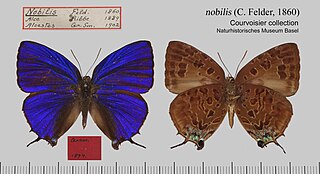
Arhopala nobilis is a butterfly in the family Lycaenidae. It was described by Cajetan Felder in 1860. It is found in the Australasian realm
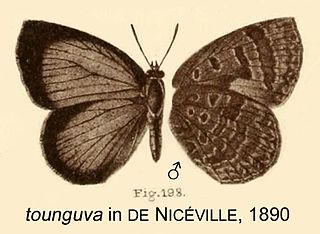
Arhopala asinarus or broad-banded oakblue, is a butterfly in the family Lycaenidae. It was described by Cajetan Felder and Rudolf Felder in 1865. It is found in the Indomalayan realm.

Arhopala pagenstecheri is a butterfly in the family Lycaenidae. It was described by Carl Ribbe in 1899. It is found in the Australasian realm where it is endemic to New Britain. The specific name honours Arnold Pagenstecher. It may be a subspecies of Arhopala florinda.

Arhopala helianthes is a butterfly in the family Lycaenidae. It was described by Henley Grose-Smith in 1902. It is found in the Australasian realm, where it is endemic to New Guinea.
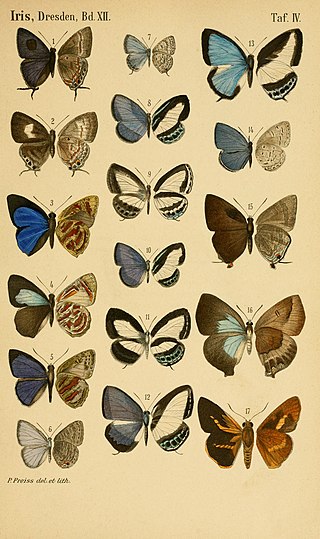
Arhopala florinda is a species of butterfly belonging to the lycaenid family described by Henley Grose-Smith in 1896. It is found in the Australasian realm where it is endemic to the Solomon Islands.
















